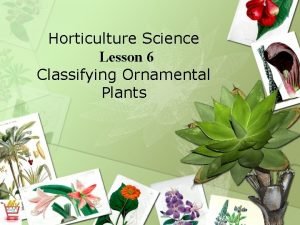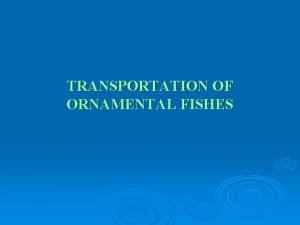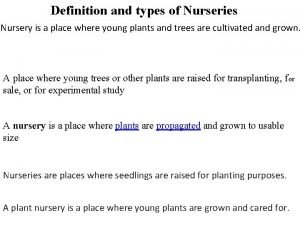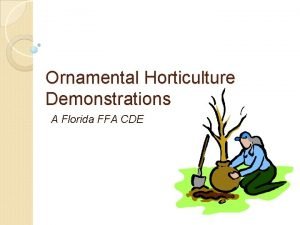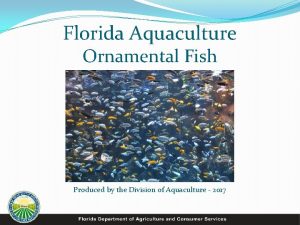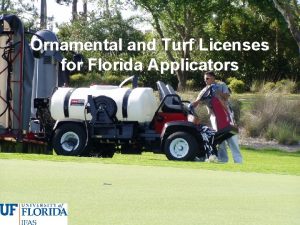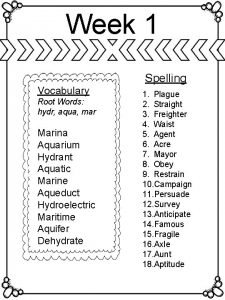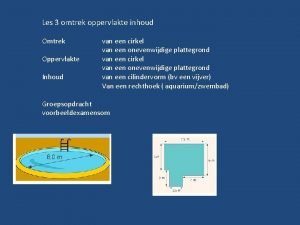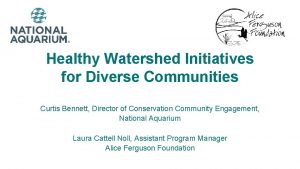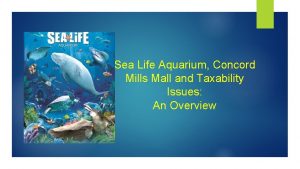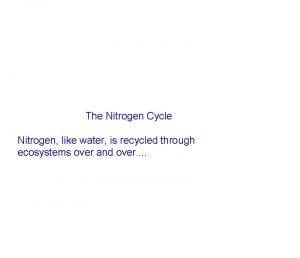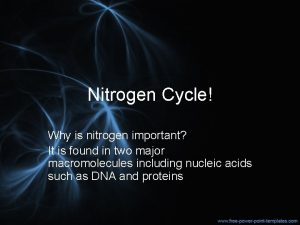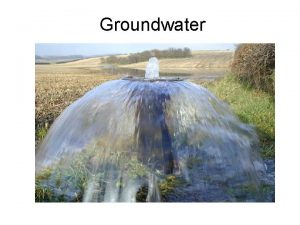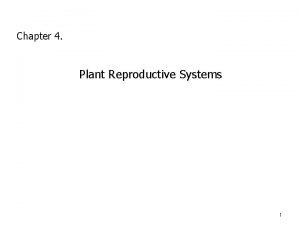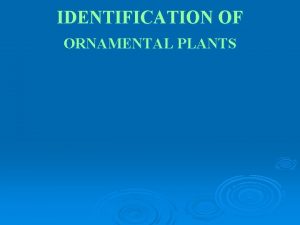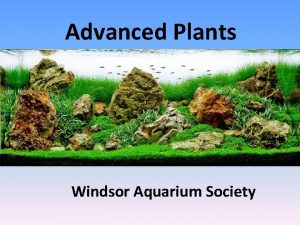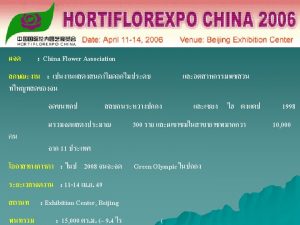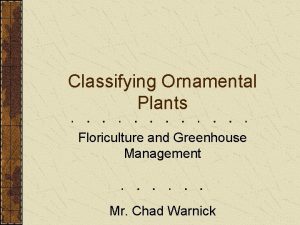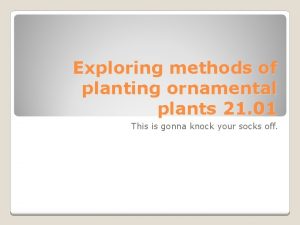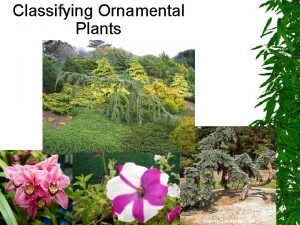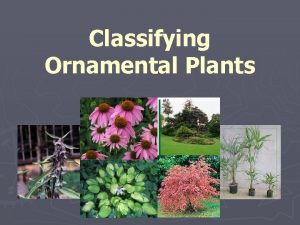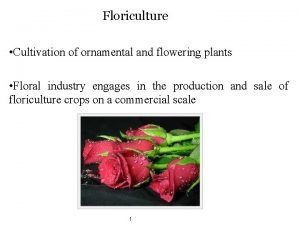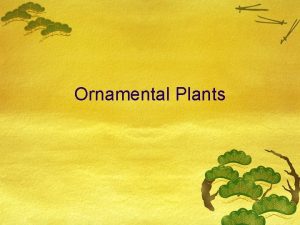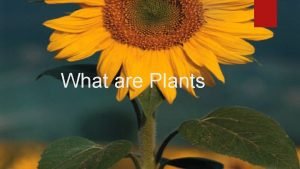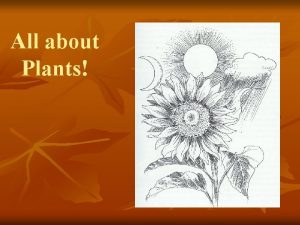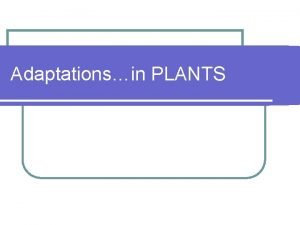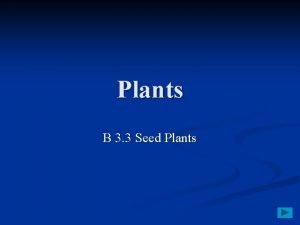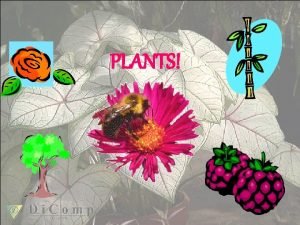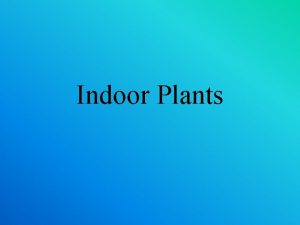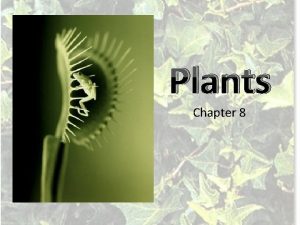ORNAMENTAL PLANTS AQUARIUM PLANTS Importance 1 2 3




































- Slides: 36

ORNAMENTAL PLANTS (AQUARIUM PLANTS)

Importance 1. 2. 3. 4. Aquarium plants gives natural look to aquarium. They provide food for fishes. Herbivorous fishes directly eat the plants. Others fishes eat the organisms attached on the leaves. They provide shelter, shade and hiding place for smaller fishes. They serve as spawning site for certain fishes.

Importance – Contd. . , Plants and fishes have symbiotic relationship. The fish waste is used by plants as an excellent fertilizer. Plants in turn remove nitrate and CO 2 from water. 6. Plants are best filters and thus help to maintain water quality. 7. Some of the plants are believed to reduce p. H of water which is suitable for breeding of certain fishes like tetra, angel etc. 5.

Types of plants 1. Floating plants Plants have their foliage (leaves) above the surface of water with roots hanging free. Ex. Eicchornia, Pistia, Spirodela, Lemna, Azolla, Wolffia, Salvinia, Riccia sp.

Types of plants 2. Emergent plants Plants having their leaves and flowers above the water surface but rooted in the bottom. Ex. Nymphaea, Nelumbo, Nymphoides.

Types of plants 3. Submerged plants Leaves are submerged in the water, may or may not be rooted. Ex. Hydrilla, Ceratophylum Myriophylum, Ottelia, Ludwigia, Saggitaria, vallisneria, Aponogeton, Cabomba, Limnophila, Ceratopteris.

Types of plants Rooted plants Hydrilla, Najas, Ottelia, Vallisneria, Potomogeton, Lagarosiphon, Chara, Nitella. Devoid of roots Ceratophyllum, Utricularia.

Types of plants 4. Marginal plants They are growing in the shallow areas of the water body (near shore). Ex. Typha, Cyperus, Ipomea, Eleocharis, Cryptocoryne, Echinodorus.

Important aquarium plants 1. Lemna minor Commonly called as duck weed. Minute (tiny) free floating aquatic weed. The roots are minute. It is a god source of feed for vegetarian fish and ducks. It is capable of purifying waste water. It spreads spontaneously at an amazing speed. It will cover the entire surface of the tank if unchecked.

Lemna minor

Important aquarium plants 2. Hydrilla sp. Submerged weed. It grows under water. But some of their leaves are coming out of water. Usually they are anchored to the hydrosoil. However, it may get completely detached from hydrosoil and continue to grow as free floating near the water surface.

Important aquarium plants 2. Hydrilla sp. The stalks are upto 3 m long. It bears whorls of 2 -9 straight dark green leaves at short intervals. The leaves are 2 cm long, and 0. 3 cm wide. It is easy to grow either it’s rooted or free floating form provided it is given good light.

Hydrilla sp.

Important aquarium plants 3. Najas minor Submerged aquatic plant. Plants are 20 -30 cm long. Stems are thin. Narrow leaves of 1 -2 cm in length. The leaves are green in colour. Sickle-shaped, 6 -10 pairs of teeth. It lives in shallow, stagnant waters. The Najas is easy to grow. It requires good light and clear water. It can thrive and grow as free floating.

Najas minor

Important aquarium plants 4. Marsilia quadrifolia Common Name : Four leaved water clover, clover fern Family : Marsiliaceae Shoreline weeds. Found in shallow waters. It has thin rhizoids anchored at the bottom. It has long filamentous stems each ends with a cluster of four oval shaped leaves.

Marsilia quadrifolia

Important aquarium plants 5. Vallisneria sp. Common Name : Tape-grass, eel grass, ribbon grass Family : Hydrocharitaceae Submerged aquatic plant. It anchored to the hydrosoil. It is a most common aquarium plant. They need bright light, but grow slowly in dim light. Ribbon like green leaved tall plant. The leaves are 30 -80 cm long and 0. 4 – 0. 8 cm broad.

Vallisneria sp.

Important aquarium plants 6. Ipomoea aquatic Common Name : Water spinach It is a common aquatic plant in India. This is used for human consumption. Found in shallow waters. It grows in shore, when water is filled in that area it detaches and become free floating. Hollow stems with white spongy floats and rooting at nodes. Leaves are elliptic or ovate-oblong. Flowers are white or pink.

Ipomoea aquatic

Important aquarium plants 7. Ceratophyllum (Horn wort) Family Name : Ceratophyllaceae Submerged, rootless, free swimming plants. Consist of long stems bearing side braches. Leaves are short, thin spikes, sharp and harsh to touch. Darkish green colour leaves. Stems bear whorls of at most 10 leaves growing at a slightly upward angle. Each leaf with 2 -4 leaflets, forked and spiky reminiscent of a pair of horns.

Ceratophyllum (Horn wort)

Important aquarium plants 8. Nymphaea sp. (water lily) Family Name : Nymphaeaceae It has roundish or oval shaped leaves floating at the water surface. Bears long stems. Attached to bottom mud rhizoid roots. Flowers are very large. White or coloured. They have a delicate scent and float at the surface (N. nouchali).

Important aquarium plants 8. Nymphaea sp. (water lily) Family Name : Nymphaeaceae N. stellata is another lily. The leaves are submerged with serrated edges. Smaller than N. nouchali. It bears small light blue flowers, purple or pink.

Nymphaea sp. (water lily)

Important aquarium plants 9. Eichhornia crassipes (water hyacinth) Floating plant has a rosette of large round leaves and swollen stalks that give the plants its buoyancy. It has hanging roots. Most abundantly growing water plant. The plant can multiple at a phenomenal rate of 15% surface area per day.

Eichhornia crassipes (water hyacinth)

Important aquarium plants 10. Cabomba sp. Family Name : Nymphaeaceae Submerged plant. Plant has stemsp upto 150 -200 cm long. Fan shaped leaves grow opposite each other at regular intervals. Leaves are beautiful, light green. It grows easily. Good light is required. It is easy to propagate by top cuttings.

Cabomba sp.

Important aquarium plants 11. Echinodorus sp. Family Name : Alismataceae Submerged plant. Commonly called Amazon sword plant. The leaves are arranged in a rosette growing out of rhizome. The leaves vary in shape. They are elongated lance-shaped, oval shaped (or) heart shaped. The leaves are 20 -40 cm long and 2 -4 cm wide. Light green colour.

Echinodorus sp.

Important aquarium plants 12. Salvinia Family Name : Salvinaceae Floating palnt. Stalk lives horizontally just below the surface and bears whorls of three leaves. Two of which float on the surface. They are oval shaped. The third leaf hangs down freely in the water (which is transformed into feathery branch similar to little roots hanging below the water). The surface of the leaf is rough with short stiff bristles.

Salvinia

Other aquatic weeds and their common name Aponogeton fenestralis Pistia sp. Ceratopteris thalictroides Crypotocoryne willisini Limnophila sessiliflora Myriophyllum Sagittaria sagitaefolia Eleocharis acicularis - Lace plant Water lettuce Indian fern (or) water sprite Hidden club Ambulia Milfoil Arrow weed Hair grass (or) needle grass

 Classifying ornamental plants answers
Classifying ornamental plants answers Transportation of ornamental fishes
Transportation of ornamental fishes Describe different types of nursery
Describe different types of nursery Florida ffa cde
Florida ffa cde Cichlid farm florida
Cichlid farm florida Lawn and ornamental license florida
Lawn and ornamental license florida Arte rupestre romano
Arte rupestre romano Volume of an aquarium in metric units
Volume of an aquarium in metric units Aquarium marketing strategy
Aquarium marketing strategy Aqua spelling
Aqua spelling Oppervlakte zwembad berekenen
Oppervlakte zwembad berekenen Curtis bennett national aquarium
Curtis bennett national aquarium Concord mall aquarium
Concord mall aquarium Hilton garden inn atlanta aquarium
Hilton garden inn atlanta aquarium Aquarium design software
Aquarium design software Calcul volume aquarium
Calcul volume aquarium An aquarium contains 6 male goldfish
An aquarium contains 6 male goldfish Tank cycling
Tank cycling Spacegoo com maze
Spacegoo com maze If an aquarium holds 80 l of water and contains 170 guppies
If an aquarium holds 80 l of water and contains 170 guppies Nitrogen cucle
Nitrogen cucle Facts about medicinal plants
Facts about medicinal plants Aromatic himalayan plant
Aromatic himalayan plant Nonvascular plant diagram
Nonvascular plant diagram Characteristics of flowering and non flowering plants
Characteristics of flowering and non flowering plants C3 plants vs c4 plants
C3 plants vs c4 plants Nonvascular plants
Nonvascular plants Importance of financial services
Importance of financial services Importance of marketing concept
Importance of marketing concept Importance of daily time record
Importance of daily time record What is the importance of resolution
What is the importance of resolution Field diary meaning
Field diary meaning Uses of ground water
Uses of ground water Importance of carbon cycle
Importance of carbon cycle Patterns of development comparison and contrast examples
Patterns of development comparison and contrast examples Importance of quality in pharmaceutical industry
Importance of quality in pharmaceutical industry Hermaphrodity
Hermaphrodity
